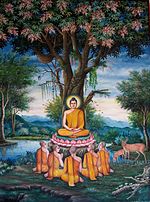Siddhārtha Gautama (pronunciation: [sɪd̪.d̪ʰaːr.t̪ʰə gəʊ.t̪ə.mə]), in Sanskrit, or Siddhattha Gotama, in Pali, was a spiritual teacher from ancient India and the founder of Buddhism. He is generally recognized by Buddhists as the Supreme Buddha (Sammāsambuddha) of our age. The precise nature of such a supreme Buddha (pronounced: [bʊd̪.d̪ʰə])—whether "merely" human or a transcendental, immortal, god-transcending being - is differently construed in Theravada and Mahayana Buddhism. tends to view him as a super-human personage of supreme teaching skill and wisdom (uncontactable after his physical death), whereas Mahayana Buddhism goes further and tends to see him as a projection of an eternal, ultimate principle of Buddhahood (see Dharmakaya), present in all phenomena, immortal and transcendent.[] The time of his birth and death are uncertain: most early 20th century historians डेट his lifetime from circa 563 BCE to 483 BCE; more recently, however, at a specialist symposium on this question, the majority of those scholars who presented definite opinions gave dates within 20 years either side of 400 BCE for the Buddha's death, with others supporting earlier or later dates.
Gautama, also known as Śākyamuni (pronounced: [ʃaː.kjə.mʊ.nɪ]) or Shakyamuni (Skt.; Pali: Sakyamuni; English: “sage of the Shakya clan”), is the key figure in Buddhism, and accounts of his life, discourses, and monastic rules were said to have been summarized after his death and memorized by the sangha. Passed down by oral tradition, the Tipitaka, the collection of teachings attributed to Gautama by the Theravada, was committed to writing some centuries later.
Standing Buddha sculpture, ancient region of Gandhara, northern Pakistan, 1st century CE, Musée Guimet, Paris

